On This Page:
- Background
- Measure
- Healthy People 2030 Target
- Data Source
- Trends and Most Recent Estimates
- Additional Information
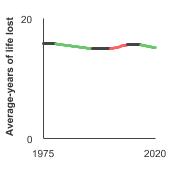
Background
Death rates alone do not provide a complete picture of the burden that deaths impose on the population. Another useful measure that may add a different dimension is years of life lost (YLL)—the years of life lost because of early death from a particular cause or disease. YLL caused by cancer helps to describe the extent to which the lives of people with cancer are cut short.
The decline in average years of life lost to cancer from 2020-2023 reflects a change in life expectancy. These estimates were based on the 2020-2023 life tables which show an average of 1-2 years lower life expectancy compared to previous life tables.
Measure
Years of Life Lost is measured as the difference between the actual age stemming from the disease/cause and the expected age of death due to a particular disease or cause. Specifically, this measure is estimated by linking life table data to each death of a person of a given age and sex. The life table permits a determination of the number of additional years an average person of that age, race, and sex would have been expected to live.
Average Years of Life Lost represents Years of Life Lost divided by the number of people who lost their lives.
Data Source
Centers for Disease Control and Prevention, National Center for Health Statistics, 1975-2023.
Healthy People 2030 Target
There is no Healthy People 2030 target for this measure.
Healthy People 2030 is a set of goals set forth by the Department of Health and Human Services.
Trends and Most Recent Estimates
- Average Years of Life Lost
By Sex
Average-years of life lost due to cancer by sex, 1975-2023 Overview Graph Detailed Trend Graphs Most Recent Estimates (2023) Average-years of life lost 95% Confidence Interval 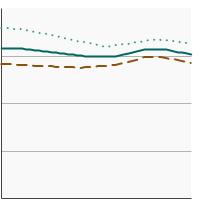

Both Sexes 
14.9 Not available Male 
13.9 Not available Female 
15.9 Not available Cancer, All Races, Both Sexes
Average-years of life lost in 2023 due to cancer, total U.S., all races, both sexes Overview graph Cause of death Years of life lost 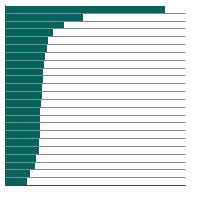

Childhood Ages (0-14) 70.4 Testis 34.3 Cervix Uteri 25.0 Brain & ONS 20.2 Hodgkin Lymphoma 17.6 Breast (Female) 17.4 Ovary 17.2 Corpus & Uterus, NOS 16.8 Stomach 16.4 Colon & Rectum 15.8 Oral Cavity & Pharynx 15.6 Melanoma of the Skin 15.6 Liver & IBD 15.3 Esophagus 15.2 All Sites Combined 14.9 Kidney & Renal Pelvis 14.6 Leukemia 14.5 Pancreas 14.5 Lung & Bronchus 14.2 Non-Hodgkin Lymphoma 13.1 Myeloma 12.4 Urinary Bladder 10.7 Prostate 9.9
- Person-years of Life Lost
All Causes of Death, All Races, Both Sexes
Person-years of life lost in 2023 by cause of death, total U.S., all races, both sexes Overview graph Cause of death Years of life lost (in thousands) 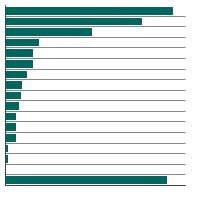

Malignant Cancers 9,114 Heart Disease 8,110 Accidents 6,377 Cerebrovascular 1,748 Chronic Lung Disease 1,748 Suicide & Self-Inflicted Injury 1,652 Diabetes Mellitus 1,449 Cirrhosis 1,175 Homicide 993 Alzheimers Disease 789 Nephritis & Nephrosis 690 Septicemia 606 Pneumonia & Influenza 578 Aortic Aneurysm & Dissection 150 HIV 123 Atherosclerosis 35 All Other Causes 10,838 All Causes of Death, All Races, Males
Person-years of life lost in 2023 by cause of death, total U.S., all races, males Overview graph Cause of death Years of life lost (in thousands) 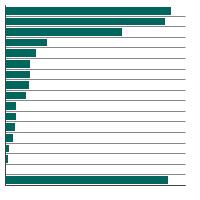

Heart Disease 4,805 Malignant Cancers 4,484 Accidents 4,399 Suicide & Self-Inflicted Injury 1,272 Diabetes Mellitus 835 Cerebrovascular 821 Homicide 791 Chronic Lung Disease 789 Cirrhosis 710 Nephritis & Nephrosis 357 Septicemia 296 Pneumonia & Influenza 296 Alzheimers Disease 249 Aortic Aneurysm & Dissection 96 HIV 90 Atherosclerosis 18 All Other Causes 5,486 All Causes of Death, All Races, Females
Person-years of life lost in 2023 by cause of death, total U.S., all races, females Overview graph Cause of death Years of life lost (in thousands) 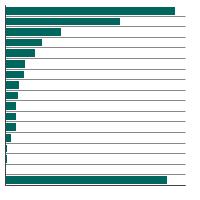

Malignant Cancers 4,630 Heart Disease 3,306 Accidents 1,978 Chronic Lung Disease 959 Cerebrovascular 928 Diabetes Mellitus 614 Alzheimers Disease 540 Cirrhosis 464 Suicide & Self-Inflicted Injury 380 Nephritis & Nephrosis 334 Septicemia 310 Pneumonia & Influenza 283 Homicide 202 Aortic Aneurysm & Dissection 53 HIV 33 Atherosclerosis 17 All Other Causes 5,352 Cancer, All Races, Both Sexes
Person-years of life lost in 2023 due to cancer, total U.S., all races, both sexes Overview graph Cause of death Years of life lost (in thousands) 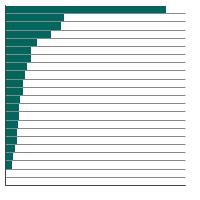

Lung & Bronchus 1,871 Colon & Rectum 852 Breast (Female) 732 Pancreas 716 Liver & IBD 457 Brain & ONS 368 Leukemia 342 Prostate 335 Non-Hodgkin Lymphoma 262 Esophagus 244 Corpus & Uterus, NOS 224 Ovary 221 Kidney & Renal Pelvis 216 Urinary Bladder 185 Oral Cavity & Pharynx 184 Stomach 180 Myeloma 144 Melanoma of the Skin 130 Cervix Uteri 104 Childhood Ages (0-14) 82 Testis 18 Hodgkin Lymphoma 18 Cancer, All Races, Males
Person-years of life lost in 2023 due to cancer, total U.S., all races, males Overview graph Cause of death Years of life lost (in thousands) 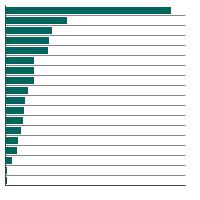

Lung & Bronchus 932 Colon & Rectum 462 Pancreas 365 Prostate 335 Liver & IBD 292 Brain & ONS 199 Leukemia 195 Esophagus 192 Non-Hodgkin Lymphoma 151 Kidney & Renal Pelvis 144 Oral Cavity & Pharynx 131 Urinary Bladder 128 Stomach 103 Melanoma of the Skin 78 Myeloma 76 Childhood Ages (0-14) 41 Testis 18 Hodgkin Lymphoma 11 Cancer, All Races, Females
Person-years of life lost in 2023 due to cancer, total U.S., all races, females Overview graph Cause of death Years of life lost (in thousands) 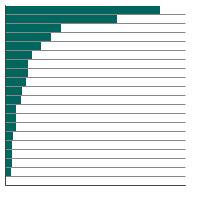

Lung & Bronchus 939 Breast (Female) 732 Colon & Rectum 390 Pancreas 351 Corpus & Uterus, NOS 224 Ovary 221 Brain & ONS 169 Liver & IBD 165 Leukemia 148 Non-Hodgkin Lymphoma 111 Cervix Uteri 104 Stomach 78 Kidney & Renal Pelvis 72 Myeloma 68 Urinary Bladder 57 Oral Cavity & Pharynx 53 Esophagus 52 Melanoma of the Skin 52 Childhood Ages (0-14) 41 Hodgkin Lymphoma 7
Additional Information
- Resources for Health Professionals. National Cancer Institute.
- Annual Report to the Nation on the Status of Cancer. National Cancer Institute.
- Life Tables. U.S. Department of Health and Human Services, Centers for Disease Control and Prevention, National Center for Health Statistics National Vital Statistics System.